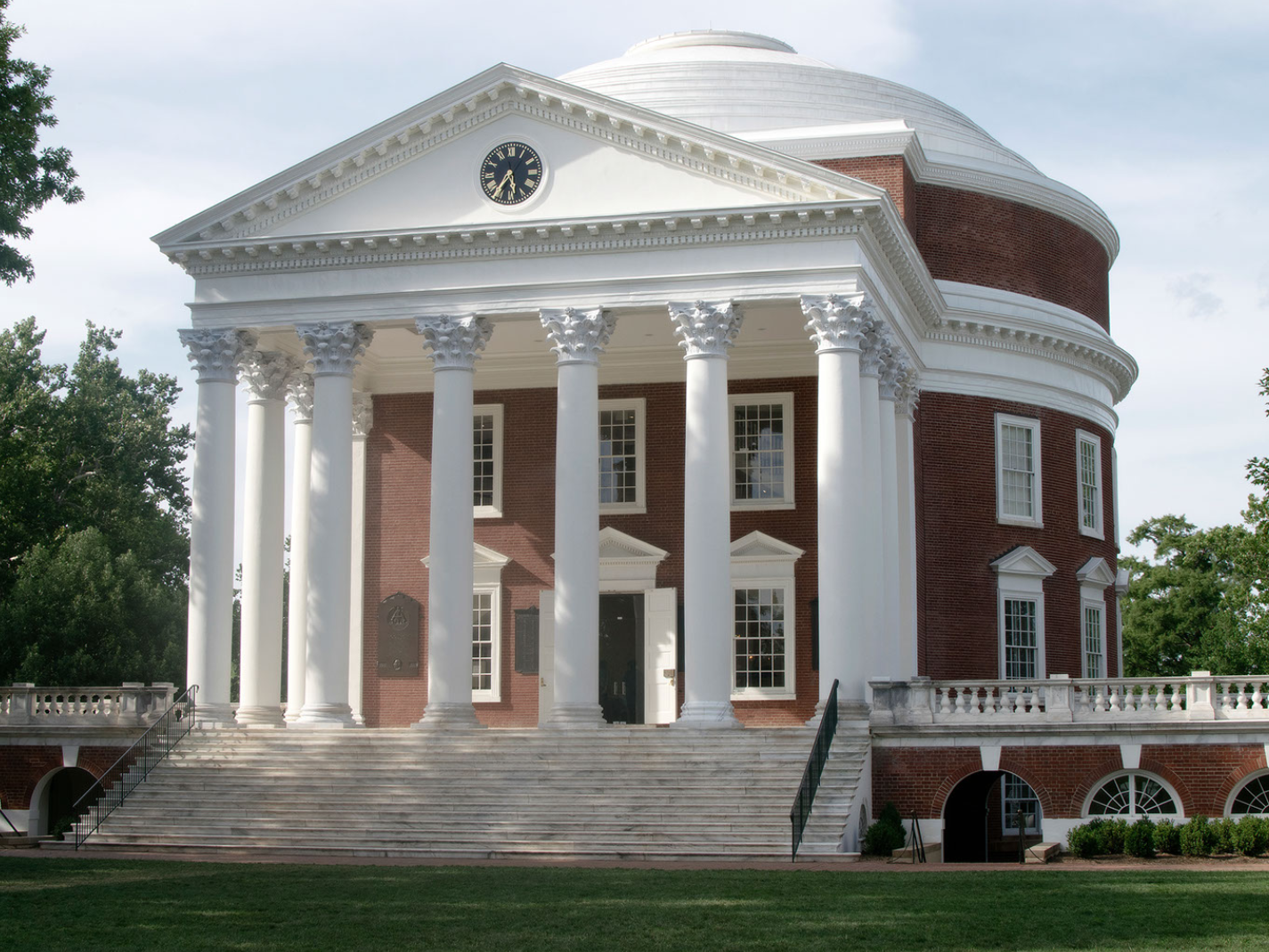
Radical Individualism and the Renaissance
(for Cayetana Álvarez de Toledo)
“By the side of the farm must early spring up a wide circle of industries …”
– John Stuart Mill, Principles of Political Economy (6.6)
The egalitarianism that has dominated American education since the 1960s needs rethinking in order to remain the engine of our nation’s creativity. As I have explained elsewhere, this paradox is peculiar to us. It reflects our history. The same classical liberalism that codified our new political order also slammed down the iron fist of revolution in 1776. But if dismissing authority is part of our character, how do we harness our urge to rebel at the slightest sign of it? Higher education especially seems to confuse authoritarianism with sources of excellence like truth, beauty, success, and respect. A better understanding of the intentions of our Founders might temper the nightmares of youth and aim them at more productive ventures.
Thomas Jefferson (1743–1826) remains America’s greatest architect, and I’m going to prove it to you below. First, Jefferson authored The Declaration of Independence and influenced James Madison’s articulation of American jurisprudence in The Constitution of the United States and The Federalist Papers. He then founded the University of Virginia (UVA) in 1819, at the center of which the Rotunda was completed after his death in 1826. The building symbolizes the “authority of nature and power of reason.” For Enlightenment philosophers like Jefferson, authority exists and reason can disclose it, but explicit in this claim is the idea that authority no longer resides in a sovereign. To see this, consider two sources for his thinking about the Rotunda: (1) Florentine artist, engineer, inventor, and architect Leonardo da Vinci (1452–1519) and (2) Spanish warrior, slave, and novelist Miguel de Cervantes (1547–1616).
The original model for the Rotunda was Vitruvius’s Pantheon in Rome. An early version of the temple was commissioned during the reign of Augustus (27 BC–14 AD) by his son-in-law Marcus Agrippa. Struck by lightning, it burned down and was rebuilt by Hadrian around 126 AD. It was da Vinci, however, who established the modern significance of the Pantheon. Vitruvian Man (c.1490) traces out natural harmonies between man and the cosmos; as he put it, Le proporzioni del corpo umano secondo Vitruvio (“The Proportions of the Human Body after Vitruvius”). The image also reflects da Vinci’s own measurements and earlier drawings, such as those in Leon Battista Alberti’s De pictura (“On Painting,” publ. 1450).
We may never know whether Jefferson was given access to King George III’s copies of da Vinci’s notebooks when he visited Buckingham House in 1786, but he was likely familiar with da Vinci’s iconic figure by way of a copy or an edition of Alberti’s treatise. Consider the fact that he owned a replica of da Vinci’s San Giovanni Battista as well as a sixteenth-century edition of Alberti’s L’architettura. Da Vinci’s influence on America’s third president is confirmed visually. Extending the lines of the buildings by Vitruvius and Jefferson, da Vinci’s figure is seen in each. The circle and the triangle formed by the head and the lower pair of hands coincide with the domes and tympanums over the porticos. Da Vinci signals the turn of the Renaissance from the classical harmony of Vitruvius to the neoclassical harmony of Jefferson.
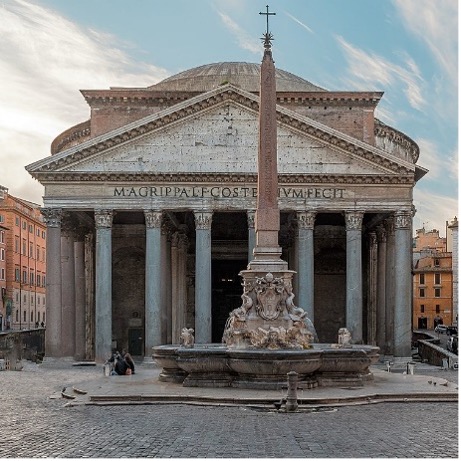
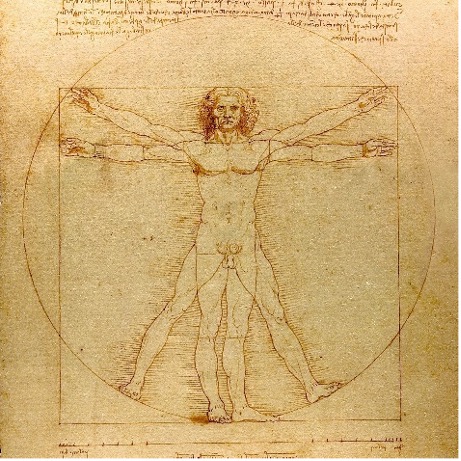
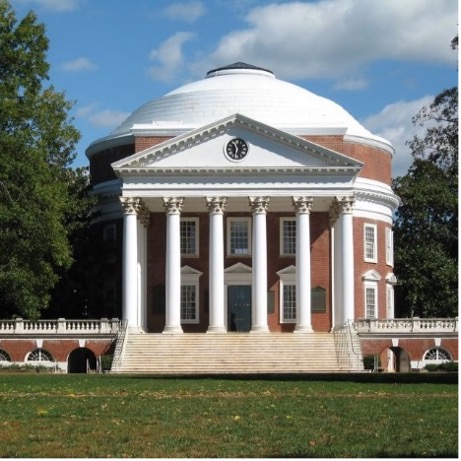
Vitruvius’s Pantheon, Da Vinci’s Vitruvian Man, and Jefferson’s Rotunda
A genealogy of the philosophy of freedom culminates in Jefferson’s egocentric architecture. After all, the reason and truth found at a university are gifts to a nation on par with a declaration or constitution. No mythical monster, no supreme being, no unimpeachable monarch trumps the social order. The common man is now the measure of all things, including politics. An emperor yields to a legal order that defends what we can call a “private sphere of liberties” around each citizen (cf. Mill’s Principles of Political Economy 4.1). As does Vitruvian Man, the Rotunda transmutes Vitruvius’s homage to Augustus into homage to the self. The Pantheon’s tympanum likely held an eagle inside a wreath or crown. Jefferson fills that void with a clock, i.e., a democratic deist subverts the imperial sovereign. Only the mortal face of Vitruvian Man stares out from the Rotunda. A similar combination of harmony, political power, and individual rights informs Madison’s use of imperial geography to defend democracy (see Federalist 10).
[Related: “What is a Nation-State?”]
Jefferson was to American architecture and politics what da Vinci and René Descartes (1596–1650) were to the art and philosophy of Italy and France. They laid the grounds for democracy by situating man at the centers of their respective fields. Alexis de Tocqueville (1805–59) grasped the political implications of these connections. In volume one of Democracy in America (1835/40), he called Jefferson “democracy’s greatest Apostol,” and he began volume two by describing the radical skepticism of Descartes’s cogito, ergo sum (“I think, therefore I am”) as the essence of the democratic spirit. Tocqueville also saw that this results in our tragic flaw:
America is thus one of the countries in the world where the precepts of Descartes are least studied and most widely applied. We need not be surprised by that. Americans do not read the works of Descartes because the state of their society diverts them from speculative study and they follow his maxims because it is this very social state which naturally disposes their minds to adopt them. Amid the continuous shifts which prevail in the heart of a democratic society, the bond which unites generations to each other becomes slack or breaks down; each person easily loses the trail of ideas coming from his forbears or hardly bothers himself about it. (DA 2.1.1)
Nevertheless, the French count can still remind Americans that Descartes’s philosophy signaled not reason’s defeat but its victory over dogma, and that the results were admirably, inevitably, and at times overly antiauthoritarian, for they “abolished accepted formulae, destroyed the reign of tradition, and overturned the authority of the teacher” (DA 2.1.1). It was Jefferson who asserted this same irreverent attitude in the field of politics.
Today many would have us ignore such continuities. Distrusting their senses and focusing on Western Civilization’s invisibly sinister mix of racism, colonialism, and fascism, they dismiss the notion of liberty as illegitimate, hypocritical, and oppressive. It’s the genetic fallacy in action. Freedom is stained and oppressive because a slaveholder inaugurated it. But it’s the trajectory of freedom that counts, not the fact that its advocates failed to fulfill their ideals. Moreover, today’s counterrevolutionaries lack credibility when they demand privilege, power, and wealth without incurring any risk or cost to themselves.
Cynics should imitate Jefferson and read Cervantes’s Don Quijote de la Mancha (1605/15). Jefferson’s knowledge of the Vitruvian Man via Alberti or da Vinci remains circumscribed, but his connection to Cervantes is fixed. Jefferson’s letters reveal his lifelong interest in the first modern novel. What explains this obsession, and what does Don Quijotehave to do with the Rotunda at UVA? One answer is again the philosophy of personal liberty. Following Da Vinci and anticipating Descartes, Cervantes also leveraged the dignity and grace of the self against the elaborate justifications of inherited wisdom. And he did so in an overtly political way.
Consider that the greatest reference to Vitruvius’s Pantheon in creative literature is part two, chapter eight of Don Quijote. Noting the paradox that some people seek fame through infamy, the mad hidalgo produces an anecdote about the Holy Roman Emperor Charles V’s brush with assassination in Rome:
The Emperor wanted to see the famous temple of the Rotunda, which in ancient times was called the ‘temple of all the gods,’ and which nowadays is better called ‘of all the saints,’ and which is the best-preserved building of all those of pagan construction in Rome, and is the one which best sustains the fame of the grandeur and magnificence of its founders. It has the form of a half orange of gigantic dimensions, and it is well lighted, though no light penetrates it save that which is allowed by a window or, to put it better, a round skylight located at its zenith; from which the Emperor was observing the building in the company of a Roman nobleman who was alongside him and explaining to him the skillful construction and ingenuity of that vast apparatus and its wondrous architecture, and having moved away from the skylight, he said to the Emperor, ‘A thousand times, your Sacred Majesty, the impulse came over me to seize your Majesty in my arms and hurl myself down from yonder skylight, so as to leave behind me in the world a fame that would last forever.’ ‘I thank you,’ responded the Emperor, ‘for not carrying such an evil thought into effect, and from now on I shall give you no further opportunity to put your loyalty to the test; and therefore I forbid you to speak to me ever again or to be wherever I am.’ And after these words he bestowed upon him a liberal bounty. My meaning, Sancho, is that the desire to acquire fame is a very powerful force. (DQ 2.8)
To most readers this funny story merely illustrates that the allure of glory can lead people to behave badly. From an antiauthoritarian perspective, however, the hidalgo presents the monarch as a kind of hypostasis, i.e., an illusion of power. Next, Sancho mocks not only Charles V but also all the other “Juliuses and Augustuses” by inquiring into their whereabouts (ubi sunt?). Don Quijote replies pointedly that the ashes of Julius Caesar are atop St. Peter’s Needle. Then he indicates that the Emperor Hadrian’s mausoleum is now the Castel Sant’Angelo. The latter gave refuge to Pope Clement VII during the Sack of Rome in 1527 by imperial troops, suggesting another slap at the Habsburgs. Finally, Sancho turns the tables on don Quijote yet again by noting that the fame of none of those powerful sovereigns measures up to the lives of the saints.
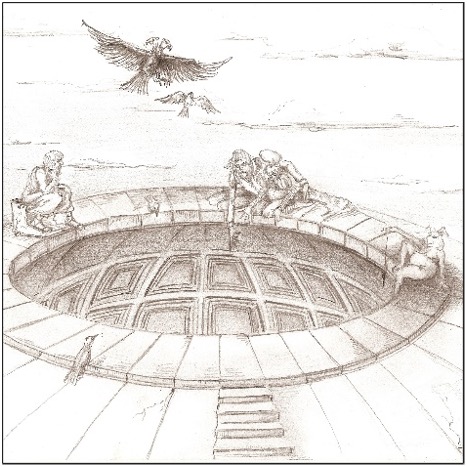
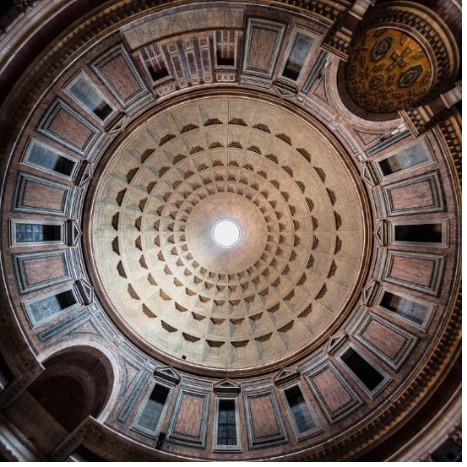
Christopher Roelofs’s illustration of DQ 2.8 and view of the Pantheon’s oculus from below
Cervantes’s story about Charles V on the brink of assassination followed by don Quijote’s and Sancho’s ironies against the worldly power of men like Caesar, Augustus, and Hadrian invites Da Vinci’s new man to break the back of authority by pulling it through the Pantheon’s oculus. This suggests revolutions should entail risk, which echoes an early modern reflection on political murder by Juan de Mariana, who reserved it for those willing to risk their lives against tyrants.
[Related: “Sum, ergo cogito: ‘I am, therefore I think'”]
Cervantes’s mockery of Charles V by way of a new “Vitruvian Man” in DQ 2.8 allows a new sociopolitical perspective on the Rotunda. Liberals like Locke, Madison, and Tocqueville saw political systems as defenses of personal rights buttressed by the arcs of an original agreement to share power. This new social order meant death to tyrants, both literally and constitutionally. The risk, of course, is a kind of political vertigo since ongoing revolutions will occasionally overstep. Still, as Jefferson put it: “The spirit of resistance to government is so valuable on certain occasions that I wish it to be always kept alive. It will often be exercised when wrong, but better so than not to be exercised at all. I like a little rebellion now and then. It is like a storm in the Atmosphere.” We should not be surprised that the most libertarian Founder flirted with the French Revolution long after most had turned away.
By contrast, sovereign dictators with the authority to impose a social order lost to civil unrest dominate the political universes of Machiavelli, Bodin, and Hobbes. What’s the difference between their view and those of Cervantes, Locke, Jefferson, Madison, and Tocqueville? Caesar has fallen. The Rotunda, in particular, shows Jefferson attracted to the antimonarchical gesture of DQ 2.8, where Vitruvius’s Pantheon functions as a potential deathtrap for Charles V.
It’s unfortunate that historian Jacob Burckhardt is out of favor. Admittedly Eurocentric and patriarchal, he argued in The Civilization of the Renaissance in Italy (1860) that self-oriented individuals who think, see, and act as we do emerged from the ashes of ancient Rome in the fifteenth-century. Burckhardt even attributed the Renaissance to a particular psychology: “The Italians of the fourteenth century knew little of false modesty or of hypocrisy in any shape; not one of them was afraid of singularity, of being and seeming unlike his neighbors.” Does anyone doubt that a dangerous madness drove many of these characters? Their patronage of castles, paintings, and epics accompanied all manner of cruelties and crimes. Thus, the quixotic paradox of so many petty, abusive men who embodied a radical form of individualism and demanded the same of their courtesans, lawyers, secretaries, artists, poets, historians, and diplomats.
Da Vinci drew Renaissance man at the center of the universe; Jefferson then beheaded the tyrant with an architecture of laws. Like a deist, an engineer of liberty sets a constitution in motion and steps away. Does Jefferson have blind spots? Does he not found another authority? His vision of liberty clearly needed further arcs toward women and other races, but as Abraham Lincoln saw it, the mechanisms that freed the slaves were set in motion by Jefferson. I find it roundly difficult to believe such a genius was unaware of his deepest contradictions. But either way, individuals must be permitted to overcome their flaws. At Monticello, “Light pours in from everywhere,” as Myron Magnet saw it in The Founders at Home: The Building of America. This is not to ignore the fact that the Enlightenment had its subterranean horrors, but rather to leave the darkness of their proper inquisition to romantics like Edgar Allan Poe and Frederick Douglass.
Images: Adobe Stock; Rabax63, Wikimedia Commons, Creative Commons Attribution-Share Alike 4.0 International license; Leonardo da Vinci, Wikimedia Commons, Public Domain; Aaron Josephson, Wikimedia Commons, Public Domain; Mohammad Reza Domiri Ganji, Wikimedia Commons, Creative Commons Attribution-Share Alike 4.0 International license.
(1) Agreed, (2) Agreed, (3) I still think the men writing The Federalist Papers and designing Monticello are revolutionaries, but your point that the electorate was seriously subdivided is well taken. That might have been a stabilizing factor. Jefferson the elitist would certainly refer to DQ 2.8 or Vitruvian Man in his architecture, so I am good with that. (4) The hypocrisy of academic egalitarianism is well taken too. Said hypocrisy suggests that distorted and excessive notions of equality have taken the political stage to a disturbing degree. I suppose then I mean the overbearing logic of egalitarianism or its conversion into an ideology of sorts. (5) Elitism and merit are not the same, and it is the overly egalitarian who tend not to distinguish.
” The same classical liberalism that codified our new political order also slammed down the iron fist of revolution in 1776.”
Respectfully, this is a misunderstanding of both the American Revolution and American history in general.
1: Only a third of Americans actually supported the Revolution — a full third openly opposed it and the remaining third was simply trying to stay out of it. There are a lot of things that aren’t mentioned much, such as the Committees of Public Safety and the actual origin of the word “Lynching.”
2: A lot of things changed between 1776 and 1787 (when the Constitution was written), including Shays’ Rebellion. Shays almost captured the US Arsenal in Springfield, Massachusetts and we’d had something similar to the French Revolution if he’d succeeded — those were Revolutionary War veterans fully intent on a second revolution.
3: The Jacksonian Democracy was far more formative than a lot of people realize — this is where the American culture went from the elites of the Revolution to the egalitarianism that America became known for. Yes, Jefferson championed the “yeoman farmer” (and never anticipated that the frontier would ever end) but he was still an elitist of sorts.
4: I don’t see “[t]he egalitarianism that has dominated American education since the 1960s” — it was always “those of us with letters after our names versus the unwashed masses” — even when the canon was expanded and token members of the unwashed masses admitted, the elitism still remained. (True egalitarianism would include faculty members demanding that their pay be the same as the college’s janitors, and you haven’t seen *that*….)
5: I think the author is confusing elitism with merit — the two are NOT the same! “[S]ources of excellence like truth, beauty, success, and respect” come from merit — from an egalitarian objective perspective of merit. (On the most objective of levels, does the bridge fall down or is it sturdy?)
I’ll agree that it is a fine point between elitism and merit, but I do believe that there is a distinction and that the failure to make it is sending us even further into the quagmire.